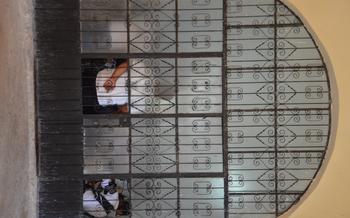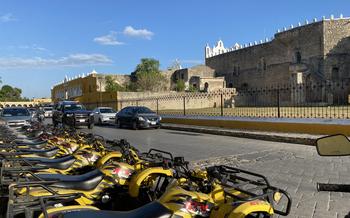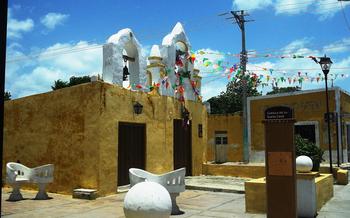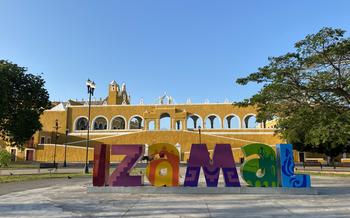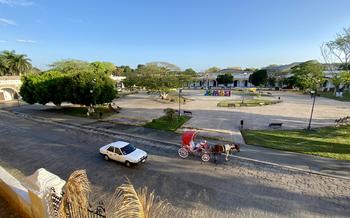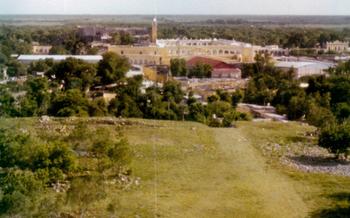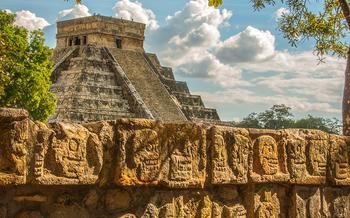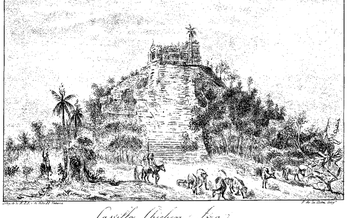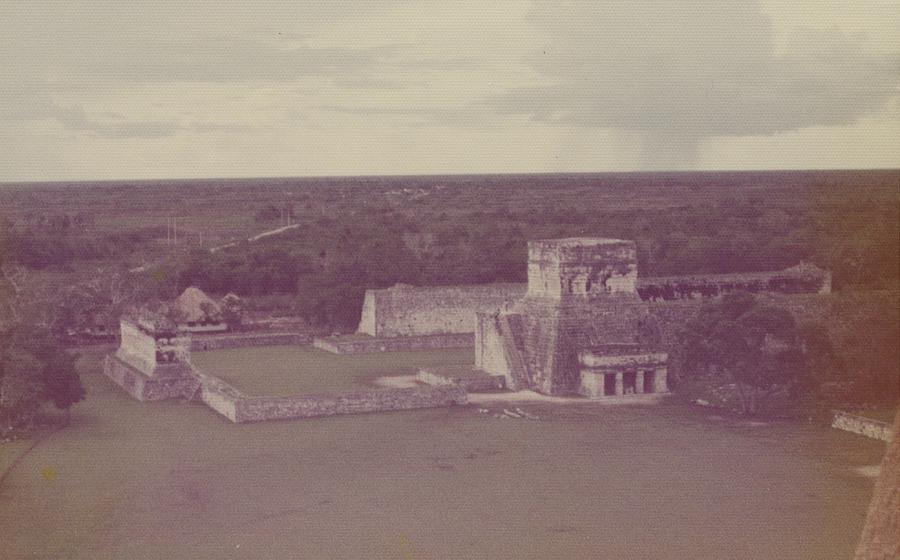
The Yellow City of Izamal
- History of Izamal. The Yellow City:
- Getting to Izamal
- Exploring the City Center
- The Franciscan Monastery
- Church of San Antonio de Padua: A Testament to Divine Beauty and Architectural Splendor
- Exploring the Yellow Buildings
- Shopping for Local Handicrafts
- Trying the Local Cuisine
- Visiting the Pyramid of Kinich Kakmó
- Exploring the Cenotes
- Attending a Traditional Mayan Ceremony
- Visiting the Hacienda Tekik de Regil
- Participating in a Cooking Class
- Museo de la Cultura Maya: Uncovering the Treasures of Mayan Heritage
- Insider Tip
History of Izamal. The Yellow City:
The city of Izamal, located in the heart of the Yucatan Peninsula in Mexico, boasts a rich and storied history that spans centuries. Its legacy dates back to the ancient Maya civilization, with evidence suggesting the area's initial settlement around 750 AD. During the Classic period, Izamal emerged as a significant regional center, renowned for its impressive architecture and religious importance. The Maya constructed several temples and platforms, including the Kinich Kakmó pyramid, dedicated to the sun god.
The arrival of the Spanish in the 16th century marked a turning point in Izamal's history. In 1548, Franciscan friars arrived in the city and established a monastery on the site of a pre-Hispanic Maya temple. This marked the beginning of Izamal's transformation into a colonial city. The friars played a pivotal role in evangelizing the Maya population and introducing Catholicism to the region. The construction of the monastery and other colonial buildings, such as the Church of San Antonio de Padua, significantly influenced the city's architectural landscape.
Under Spanish rule, Izamal became an important center for the production of henequen, a type of agave fiber used in the production of rope and cordage. This industry brought economic prosperity to the city and led to the construction of numerous haciendas, or large agricultural estates. However, the decline of the henequen industry in the early 20th century had a profound impact on Izamal's economy, leading to a period of stagnation and decline.
In recent decades, Izamal has experienced a resurgence of interest due to its rich cultural heritage and well-preserved colonial architecture. The city's unique charm and vibrant colors have attracted tourists from around the world, contributing to its growing popularity as a cultural and historical destination.
Getting to Izamal
Izamal, the enchanting "Yellow City" of Mexico, is conveniently accessible from major cities in the country. Whether you're based in Merida, Cancun, or elsewhere, there are several transportation options to suit your travel plans.
From Merida, the capital of Yucatan, Izamal is just a short and scenic bus ride away. Buses depart frequently from Merida's main bus station and take approximately 1 hour and 30 minutes to reach Izamal. The journey offers a glimpse into the region's landscapes and villages, making it an enjoyable part of the experience.
If you're coming from Cancun, the popular tourist destination on the Caribbean coast, there are several bus options available. Direct buses from Cancun to Izamal typically take around 4 hours, with departures throughout the day. Alternatively, you can take a bus to Merida and then transfer to a connecting bus to Izamal, which offers more flexibility in terms of schedules.
For those who prefer a more personalized experience, renting a car is another great option. The drive from Merida to Izamal takes about 1 hour and 20 minutes, allowing you to set your own pace and explore the region at your leisure. Car rentals are readily available at both Merida and Cancun airports, providing convenience and flexibility for your journey.
No matter which mode of transportation you choose, getting to Izamal is a breeze. The city's strategic location in the Yucatan Peninsula makes it easily accessible from various points, ensuring a smooth and enjoyable travel experience.
Exploring the City Center
The city center of Izamal, known as the "Plaza Grande," is a captivating blend of colonial architecture and Mayan heritage. The heart of the plaza is the Franciscan monastery, an imposing structure that dominates the skyline with its grand facade and bell tower. The monastery's atrium, with its arched walkways and lush gardens, provides a tranquil oasis amidst the bustling city.
Adjacent to the monastery is the Church of San Antonio de Padua, a beautiful church with an intricately carved facade and stunning interior. The church is dedicated to Saint Anthony of Padua, the patron saint of Izamal, and is a popular pilgrimage site for both locals and visitors.
Beyond the main plaza, the streets of Izamal are lined with colorful colonial buildings, many of which have been converted into shops, restaurants, and cafes. The city's unique charm lies in its vibrant hues, with buildings painted in shades of yellow, orange, and pink, creating a picturesque backdrop for exploring the city's hidden gems.
The layout of Izamal's streets reflects the influence of Mayan culture, with the city center arranged in a grid pattern that is believed to have been inspired by the ancient Mayan city of Chichen Itza. This grid pattern is still evident today, and it adds to the city's unique character and charm.
The Franciscan Monastery
Izamal is home to a magnificent architectural masterpiece, the Franciscan Monastery, which stands as a testament to the city's rich religious and cultural heritage.
The monastery's construction began in the 16th century under the direction of the Franciscan friars, who played a pivotal role in spreading Christianity throughout the region. The imposing facade of the monastery, adorned with intricate carvings and sculptures, is a testament to the skill and artistry of the Mayan craftsmen who worked on its construction.
Inside the monastery, visitors are greeted by a serene and spacious atrium, surrounded by arched walkways and lush gardens. The cloisters, with their elegant columns and vaulted ceilings, provide a tranquil retreat for contemplation and prayer. The monastery also houses several chapels, each dedicated to a different saint or religious figure, showcasing the diverse devotional practices of the Catholic faith.
The Franciscan Monastery is not just a religious landmark but also a symbol of cultural exchange and assimilation. The friars who built the monastery incorporated Mayan elements into the architecture, blending European and indigenous traditions to create a unique and harmonious style. This fusion of cultures can be seen in the intricate carvings depicting Mayan deities and symbols, which adorn the monastery's walls and altars.
The monastery's enduring legacy lies in its role as a center of education and cultural preservation. The Franciscans established a school within the monastery, where Mayan children were taught Spanish, religion, and practical skills. This institution played a crucial role in preserving Mayan knowledge and traditions, fostering a sense of cultural continuity amidst the changes brought by colonization.
Today, the Franciscan Monastery stands as a living testament to the enduring spirit of Izamal. It is a place of worship, a repository of history, and a symbol of the city's vibrant cultural heritage, drawing visitors from around the world to marvel at its beauty, learn about its past, and experience the profound spirituality that permeates its walls.
Church of San Antonio de Padua: A Testament to Divine Beauty and Architectural Splendor
Amidst the captivating cityscape of Izamal, the Church of San Antonio de Padua stands as a testament to the city's rich religious heritage and architectural prowess. Constructed in the 16th century, this magnificent edifice is dedicated to Saint Anthony of Padua, a revered figure in the Catholic faith. Its intricate facade, adorned with delicate carvings and sculpted figures, captivates the eyes and hints at the wonders that lie within.
Step inside the church, and you will be greeted by a breathtaking spectacle of art and devotion. The vaulted ceilings soar overhead, adorned with vibrant frescoes depicting scenes from the Bible and the life of Saint Anthony. The walls are adorned with intricate murals, each stroke telling a story of faith and devotion. The altarpieces, with their gilded details and meticulously crafted imagery, are a testament to the skill and artistry of the craftsmen who created them.
One of the most striking features of the church is its collection of intricately carved wooden statues. These masterpieces depict various saints and religious figures, each with their own unique expression and posture. The attention to detail is simply astonishing, from the delicate folds of their garments to the serene expressions on their faces.
The Church of San Antonio de Padua is not merely a place of worship; it is a living testament to the enduring power of faith and the beauty of human creativity. Whether you are a devout Catholic, an art enthusiast, or simply someone who appreciates the finer things in life, this church is a must-see destination in the Yellow City of Izamal.
Exploring the Yellow Buildings
Izamal is renowned for its enchanting yellow-painted buildings, earning it the nickname "The Yellow City". This unique tradition dates back to the 16th century when the Spanish conquistadors ordered the city to be painted yellow to symbolize purity and happiness. The vibrant yellow hue has become synonymous with Izamal, creating a striking and visually appealing urban landscape.
Strolling through the streets of Izamal is a feast for the eyes, as the yellow buildings radiate warmth and cheerfulness. The uniformity of the color creates a harmonious and cohesive cityscape, highlighting the city's architectural features and colonial charm. The yellow-painted facades contrast beautifully with the blue sky, providing ample opportunities for stunning photographs.
The tradition of painting the buildings yellow has not only aesthetic value but also cultural significance. In Mayan culture, yellow represents the sun and maize, which were considered sacred and essential for life. By painting the city yellow, the inhabitants pay homage to their Mayan heritage and express their connection to the natural world.
Exploring the yellow buildings of Izamal is a unique and immersive experience that transports visitors to a bygone era. The harmonious blend of colors, architecture, and history creates a magical ambiance that invites travelers to wander, discover, and appreciate the rich cultural tapestry of this enchanting city.
Shopping for Local Handicrafts
Among the vibrant streets of Izamal, one can discover a treasure trove of locally crafted handicrafts. The central plaza hosts a lively market where artisans showcase their creations, offering a diverse array of textiles, pottery, and intricate jewelry. Each item is a testament to the skill and creativity of the local artisans, who pour their hearts and souls into their work.
When shopping for handicrafts in Izamal, it's essential to engage in the art of bargaining. This cultural practice allows you to connect with the artisans and appreciate the value of their work. Don't be afraid to ask questions about the techniques and materials used; the artisans are often more than happy to share their stories. By supporting local artisans, you not only take home a unique piece of Izamal but also contribute to preserving the rich cultural heritage of the region.
The handicrafts of Izamal are deeply rooted in Mayan traditions and symbolism. The intricate designs and vibrant colors reflect the ancient beliefs and way of life of the Maya. Whether it's a colorful textile adorned with traditional motifs or a piece of hand-painted pottery, each item carries a story and offers a glimpse into the rich cultural tapestry of the region.
Trying the Local Cuisine
When in Izamal, indulging in the delectable regional dishes is a must. The city offers a culinary journey that tantalizes taste buds and immerses visitors in the flavors of the Yucatan Peninsula. Among the must-try dishes is cochinita pibil, a traditional slow-roasted pork dish cooked in banana leaves and seasoned with achiote paste. The result is a tender and flavorful meat that melts in your mouth. Another local favorite is papadzules, a dish consisting of corn tortillas filled with hard-boiled eggs, topped with a pumpkin seed sauce, and served with pickled red onions. The combination of flavors and textures in this dish is simply irresistible.
To fully experience the culinary delights of Izamal, venture into the local markets and restaurants. The Mercado Municipal, located in the heart of the city, is a vibrant hub of activity where you can find fresh produce, spices, and a variety of prepared foods. Here, you can sample regional delicacies such as panuchos, salbutes, and empanadas, all bursting with flavor. For a more upscale dining experience, head to one of the city's charming restaurants, where you can savor Yucatecan cuisine prepared with fresh, local ingredients and presented with artistic flair.
Sampling the local cuisine is not just about satisfying your taste buds; it's also about immersing yourself in the culture and traditions of Izamal. The flavors, aromas, and ingredients used in Yucatecan dishes reflect the region's rich history and heritage. By indulging in the local culinary delights, you'll gain a deeper appreciation for the vibrant and diverse culture of this captivating city.
Visiting the Pyramid of Kinich Kakmó
The Pyramid of Kinich Kakmó, located just outside the city center, is a testament to the ancient Mayan civilization that once thrived in Izamal. Dedicated to the Mayan sun god, Kinich Kakmó, the pyramid is a symbol of the city's rich cultural heritage.
The pyramid, which stands at an impressive 34 meters (112 feet) tall, offers breathtaking views of the surrounding countryside. The climb to the top, though challenging, is well worth the effort for the panoramic vistas that await. From the summit, visitors can admire the sprawling city of Izamal, with its distinctive yellow buildings and the Franciscan monastery dominating the skyline.
The Pyramid of Kinich Kakmó is not only a historical landmark but also a sacred site for the Maya. It is believed that the pyramid was used for religious ceremonies and rituals, and it continues to hold deep spiritual significance for the Mayan people.
For those interested in learning more about the ancient Maya and their culture, a visit to the Pyramid of Kinich Kakmó is a must. This impressive structure offers a glimpse into the past and provides a tangible connection to the rich heritage of the Yucatan Peninsula.
Exploring the Cenotes
Among the many natural wonders that await you in Izamal, the cenotes stand out as must-visit attractions. These sinkholes, formed by the collapse of limestone bedrock, reveal crystal-clear waters that invite you to take a refreshing dip. Whether you're a swimming enthusiast, a snorkeling adventurer, or a diving explorer, Izamal's cenotes offer something for everyone.
The cenotes in the vicinity of Izamal are easily accessible, making them a convenient addition to your itinerary. Cenote Azul, located just a short drive from the city center, is a popular choice for its stunning blue waters and well-maintained facilities. Cenote Ik Kil, situated near Chichen Itza, is another must-see, boasting a majestic backdrop of towering trees and cascading vines.
Beyond their natural beauty, the cenotes hold a deep cultural significance for the Maya. They were considered sacred portals to the underworld, where the Maya believed their ancestors resided. The cenotes were also used for ritual bathing, purification ceremonies, and offerings to the gods.
As you explore the cenotes of Izamal, it's important to remember that these natural wonders are delicate ecosystems. To preserve their pristine condition, be sure to follow the guidelines and regulations set in place. Avoid using harsh chemicals or sunscreens, and dispose of waste properly. By respecting the environment, we can ensure that future generations can continue to enjoy the beauty and tranquility of these sacred cenotes.
Attending a Traditional Mayan Ceremony
In the heart of Izamal, you'll find a unique opportunity to witness and participate in a traditional Mayan ceremony. These ceremonies, deeply rooted in Mayan culture and spirituality, offer a glimpse into the ancient traditions that still thrive in this region. From weddings and baptisms to healing rituals and purification ceremonies, each ceremony holds a special significance in the lives of the Maya.
Participating in a Mayan ceremony is an immersive experience that allows you to connect with the local community and gain a deeper understanding of their beliefs and customs. Whether you choose to observe or actively participate, it's important to approach the ceremony with respect and humility.
Local shamans, known as ah-men, guide these ceremonies, invoking ancient Mayan deities and spirits. The ceremonies often involve offerings, prayers, and the burning of copal incense, creating a sacred and mystical atmosphere.
Attending a Mayan ceremony is a transformative experience that will leave you with a profound appreciation for the rich cultural heritage of the Yucatan Peninsula. Remember, it's crucial to respect local customs and traditions, ask permission before taking photos, and offer a small donation to support the local community.
Visiting the Hacienda Tekik de Regil
Nestled in the countryside, just a short drive from Izamal, lies the historic Hacienda Tekik de Regil. This former sisal plantation offers a glimpse into the region's rich agricultural heritage and Mayan culture. Explore the hacienda's beautifully preserved colonial architecture, wander through its lush gardens, and learn about the intricate process of sisal production, which played a vital role in the economy of the Yucatan Peninsula.
Today, the hacienda has been transformed into a cultural center and museum, showcasing exhibits on the history of the sisal industry, the daily life of the hacienda workers, and the enduring legacy of Mayan culture in the region. Immerse yourself in the fascinating stories and artifacts that bring the hacienda's past to life.
At the Museo de la Hacienda Tekik de Regil, you can delve deeper into the intricate world of sisal production. Discover the various stages of the process, from planting and harvesting the agave plant to extracting the valuable fibers used to create ropes, twine, and other durable materials. Learn about the backbreaking labor that went into sisal production and the crucial role it played in shaping the economic and social landscape of the Yucatan.
The hacienda is not just a museum but also a vibrant cultural center that hosts events, workshops, and performances throughout the year. Participate in a traditional cooking class, using fresh local ingredients to create delicious Yucatecan dishes. Attend a cultural performance, showcasing the vibrant music, dance, and storytelling traditions of the Maya. Or simply relax in the tranquil gardens, surrounded by lush tropical vegetation and the gentle sounds of nature.
Visiting the Hacienda Tekik de Regil is an enriching experience that combines history, culture, and nature. It offers a unique opportunity to learn about the region's rich heritage, appreciate the resilience and ingenuity of the Maya, and gain a deeper understanding of the complex relationship between humans and the environment in the Yucatan Peninsula.
Participating in a Cooking Class
Enrich your Izamal experience by participating in a hands-on cooking class and learning the art of preparing traditional Yucatecan dishes. These classes are a fantastic way to immerse yourself in the local culture, interact with friendly chefs, and acquire new culinary skills.
Under the guidance of experienced instructors, you'll embark on a culinary journey, discovering the secrets behind mouthwatering dishes like cochinita pibil, papadzules, and more. Using fresh, locally sourced ingredients, you'll learn the techniques and recipes passed down through generations.
As you cook, engage in lively conversations with your fellow participants and instructors, sharing laughter, stories, and cultural insights. These cooking classes provide an unforgettable opportunity to connect with the local community and gain a deeper appreciation for the region's rich culinary heritage.
Whether you're a seasoned cook or a novice in the kitchen, these classes cater to all skill levels. Embrace the chance to bring back not just souvenirs but also the knowledge to recreate these delicious dishes in your own kitchen, impressing your family and friends with your newfound culinary prowess.
Museo de la Cultura Maya: Uncovering the Treasures of Mayan Heritage
Housed within the walls of a restored 16th-century convent, the Museo de la Cultura Maya stands as a testament to the rich history and enduring legacy of the Maya civilization. As you step through its doors, you'll embark on a captivating journey through time, immersing yourself in the vibrant culture and traditions of this ancient people.
The museum's extensive collection boasts a treasure trove of artifacts, textiles, and artwork, each piece carefully curated to showcase the artistry, ingenuity, and spiritual beliefs of the Maya. From intricately carved jade figurines to finely woven textiles adorned with vibrant colors and patterns, the exhibits provide a glimpse into the daily lives, rituals, and beliefs of this remarkable civilization.
The museum's interactive displays and informative panels bring the Maya world to life, shedding light on their complex social structures, advanced mathematical and astronomical knowledge, and sophisticated writing system. You'll learn about their agricultural practices, their intricate calendar system, and their profound understanding of the cosmos.
A visit to the Museo de la Cultura Maya is an essential experience for anyone seeking to delve deeper into the rich tapestry of Mayan history and culture. Within these walls, you'll discover the enduring spirit of a civilization that continues to captivate and inspire generations to come.
Insider Tip
Plan your visit to Izamal during the annual carnival celebration for an unforgettable experience. The city transforms into a vibrant spectacle of colors, music, and dance. Elaborate parades featuring colorful floats, traditional costumes, and lively music fill the streets. Participate in the festivities, dance to the rhythm of traditional Yucatecan music, and immerse yourself in the joyous atmosphere. Don't miss the opportunity to witness the unique cultural expressions and traditions of Izamal during this vibrant celebration.
